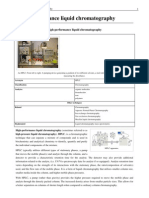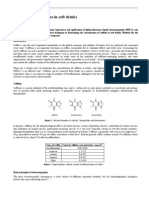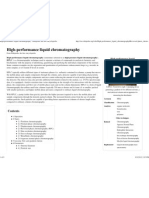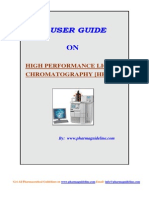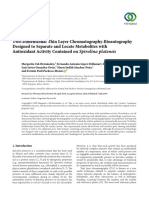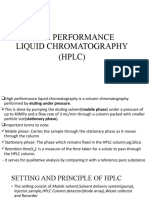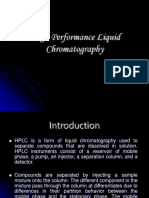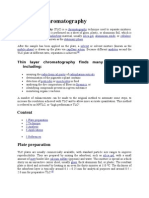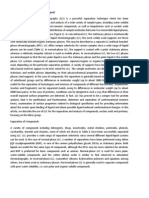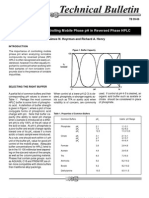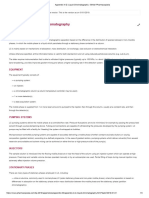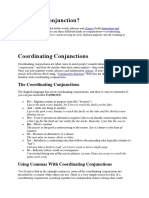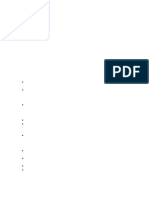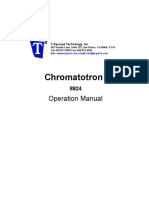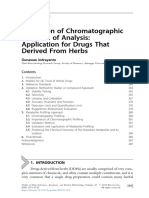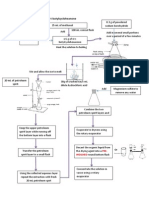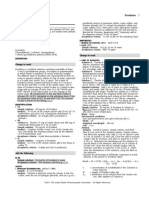0 ratings0% found this document useful (0 votes)
55 viewsTLC Modes Used For Lipophilicity Estimation
TLC Modes Used For Lipophilicity Estimation
Uploaded by
Anas ArdianaThe document discusses different TLC modes used for estimating lipophilicity, including reversed phase TLC, micellar liquid chromatography, normal phase TLC, and salting-out TLC. Each mode is described in terms of the mechanism of retention, typical stationary and mobile phases used, and examples of compounds studied by each technique.
Copyright:
© All Rights Reserved
Available Formats
Download as DOCX, PDF, TXT or read online from Scribd
TLC Modes Used For Lipophilicity Estimation
TLC Modes Used For Lipophilicity Estimation
Uploaded by
Anas Ardiana0 ratings0% found this document useful (0 votes)
55 views5 pagesThe document discusses different TLC modes used for estimating lipophilicity, including reversed phase TLC, micellar liquid chromatography, normal phase TLC, and salting-out TLC. Each mode is described in terms of the mechanism of retention, typical stationary and mobile phases used, and examples of compounds studied by each technique.
Original Description:
Kromatografi Lapis Tipis
Original Title
TLC modes used for lipophilicity estimation
Copyright
© © All Rights Reserved
Available Formats
DOCX, PDF, TXT or read online from Scribd
Share this document
Did you find this document useful?
Is this content inappropriate?
The document discusses different TLC modes used for estimating lipophilicity, including reversed phase TLC, micellar liquid chromatography, normal phase TLC, and salting-out TLC. Each mode is described in terms of the mechanism of retention, typical stationary and mobile phases used, and examples of compounds studied by each technique.
Copyright:
© All Rights Reserved
Available Formats
Download as DOCX, PDF, TXT or read online from Scribd
Download as docx, pdf, or txt
0 ratings0% found this document useful (0 votes)
55 views5 pagesTLC Modes Used For Lipophilicity Estimation
TLC Modes Used For Lipophilicity Estimation
Uploaded by
Anas ArdianaThe document discusses different TLC modes used for estimating lipophilicity, including reversed phase TLC, micellar liquid chromatography, normal phase TLC, and salting-out TLC. Each mode is described in terms of the mechanism of retention, typical stationary and mobile phases used, and examples of compounds studied by each technique.
Copyright:
© All Rights Reserved
Available Formats
Download as DOCX, PDF, TXT or read online from Scribd
Download as docx, pdf, or txt
You are on page 1of 5
TLC modes used for lipophilicity estimation
4.1. Reversed phase thin layer chromatography
The mechanism of the retention in RP-TLC is based on partitioning of the substance between
hydrophobic stationary phase and hydrophilic mobile phase, so the retention is generally strictly
correlated with the lipophilicity of the solutes
Polar stationary phases, such as silica gel, aluminum oxide and cellulose, impregnated with oil
substance or coated with polymers, can be used for RP-TLC
Therefore, the commercial chemically bonded stationary phases, which do not require any
sophisticated initial preparation, are generally preferred.
RP-TLC great benefits is a wider range of applicable solvents as compared to RP-HPLC like:
acetone (since a high ultraviolet absorbance is avoided in HPLC), propan-2-ol, ethanol and
dioxane (application of these viscous solvents results in high back-pressure in HPLC) as well as
methanol and acetonitrile (often used in both TLC and HPLC).
Hypotensive activity (determined as a measure of central alphaadrenergic activity and expressed
as pC25) of some -adrenergic and imidazoline receptor ligands was also correlated with retention
of these substances in RP-TLC
4.2. Micellar liquid chromatography
Micellar liquid chromatography (MLC) is a mode of reversedphase liquid chromatographic
(RPLC) where the mobile phase contains surfactant above its critical micellar concentration
(CMC).
It is worth to emphasize that surfactants in MLC not only affects the properties of mobile phase
but also adsorb on the stationary phase influencing its characteristics like reduction of
silanophilic interactions. In the ideal situation, the mobile phase should be free of organic
solvent. However, the addition of small amounts of organic solvent to micellar, aqueous solution
provides some advantages like shorter time of analysis, improved peak shape and efficiency as
well as resolution
The MLC have unique advantages, since in this chromatographic system, solutes retention is
governed by three different equilibriums. Those are solutes distribution between the micelles and
the bulk phase, partition between the stationary phase and the bulk phase and direct transfer
between surfactant-modified bed surface to the micelles.
The micelles have amphiphilic character, so both nonpolar and polar interactions between
micelles and analytes take place.
4.3. Normal phase thin layer chromatography (NP-TLC)
NP-TLC is a less frequently applied technique for lipophilicity estimation. In contrary to above
discussed techniques, NP-TLC is related to adsorption chromatography, so different molecular
mechanism of retention is involved. Usually, the mobile phase contains two organic solvents,
polar and non-polar. The non-polar solvents, such as benzene, cyclohexane, carbon tetrachloride
or toluene, are highly toxic and should be eliminated from analytical protocols. Silica gel,
Florisil® or polyamide are exemplary stationary phases used in NP-TLC
Reports concerning NP-TLC parameters of bile acids and their oxo-derivatives were presented.
Correlation between molecular parameters (total polar surface area, molecular weight) and
chromatographic data of bile acids derivatives with in silico determined human intestinal
absorption, PPB, skin permeability and log BB [60]. Furthermore, in silico-determined
bioactivity (protein coupled receptor ligand, ion channel modulator, nuclear receptor inhibitor,
protease inhibitor) depended strongly on the same descriptors
The RP-TLC and NP-TLC approaches were compared as potential tools for lipophilicity
estimation for compounds with a phenanthrene skeleton.
4.4. Salting-out thin-layer chromatography (SOTLC)
The inorganic salts are quite common ingredients of mobile phase in liquid chromatography. In
most cases, they are added as a buffer components to adjust the pH value of the solution. The
inorganic salt at low concentration can act similarly to ion-pairing reagents, increasing the
retention time of ionized compounds. On the other hand, aqueous solution of inorganic salts at
high concentrations are used as mobile phases in SOTLC.
The commonly accepted theory assumes that under these conditions, non-specific hydrophobic
interactions govern the chromatographic mechanism
it can be expected that the retention of solutes is associated with its lipophilicity. However,
several inorganic salts can be applied as modifiers of mobile phase among which ammonium
sulfate is the most widely used addition in SOTLC (because of its strong salting-out properties).
Highly polar sorbents such as silica gel, cellulose, or aluminum oxide, are commonly utilized as
stationary phases
Several SOTLC systems, containing different inorganic salts and three types of stationary
phases: silica gel, cellulose plates and basic aluminum oxide, were compared as potential tools
for lipophilicity estimation of macrolide antibiotics.
Correlations between SOTLC retention constants and intestinal absorption of angiotensin
converting enzyme (ACE) inhibitors were described by Odovic´ and co-workers. Topological
polar surface area (TPSA) and RM0 parameters were used for construction of
QSAR models which were proposed as an alternative way for prediction of intestinal absorption
for angiotensin-converting enzyme inhibitors
Mode TLC digunakan untuk estimasi lipofilikitas
4.1. Kromatografi lapisan tipis fase terbalik
Mekanisme retensi dalam RP-TLC didasarkan pada partisi zat antara fase stasioner hidrofobik
dan fase seluler hidrofilik, sehingga retensi umumnya berkorelasi ketat dengan lipofilikitas solute
Fase stasioner kutub, seperti gel silika, aluminium oksida dan selulosa, diresapi dengan zat
minyak atau dilapisi dengan polimer, dapat digunakan untuk RP-TLC
Oleh karena itu, fase stasioner terikat kimia komersial, yang tidak memerlukan persiapan awal
yang canggih, umumnya lebih disukai.
RP-TLC manfaat besar adalah berbagai pelarut yang berlaku dibandingkan dengan RP-HPLC
seperti: aseton (karena penyerapan ultraviolet tinggi dihindari di HPLC), propan-2-ol, etanol dan
dioksan (aplikasi pelarut kental ini menghasilkan tekanan punggung tinggi di HPLC) serta
metanol dan acetonitrile (sering digunakan dalam TLC dan HPLC).
Aktivitas hipotensif (ditentukan sebagai ukuran aktivitas alfaadrenerik pusat dan dinyatakan
sebagai pC25) dari beberapa ligan reseptor adrenerrgik dan imidazoline juga berkorelasi dengan
retensi zat-zat ini dalam RP-TLC
4.2. Kromatografi cair micellar
Micellar liquid chromatography (MLC) adalah mode reversedphase liquid chromatographic
(RPLC) di mana fase mobile mengandung surfaktan di atas konsentrasi micellar kritis (CMC).
Perlu ditekankan bahwa surfaktan di MLC tidak hanya mempengaruhi sifat fase seluler tetapi
juga adsorb pada fase stasioner yang mempengaruhi karakteristiknya seperti pengurangan
interaksi silanofilik. Dalam situasi ideal, fase seluler harus bebas dari pelarut organik. Namun,
penambahan sejumlah kecil pelarut organik untuk micellar, larutan berdasi memberikan
beberapa keuntungan seperti waktu analisis yang lebih singkat, peningkatan bentuk puncak dan
efisiensi serta resolusi
MLC memiliki keunggulan unik, karena dalam sistem kromatografi ini, retensi solute diatur oleh
tiga keseimbangan yang berbeda. Itu adalah distribusi solute antara micelles dan fase massal,
partisi antara fase stasioner dan fase massal dan transfer langsung antara permukaan tempat tidur
yang dimodifikasi surfaktan ke micelles.
Micelles memiliki karakter amfifilik, sehingga interaksi nonpolar dan kutub antara micelles dan
analytes terjadi.
4.3. Kromatografi lapisan tipis fase normal (NP-TLC)
NP-TLC adalah teknik yang kurang sering diterapkan untuk estimasi lipofilikitas. Berbeda
dengan teknik yang dibahas di atas, NP-TLC terkait dengan kromatografi adsorpsi, sehingga
berbeda molekuler
mekanisme retensi terlibat. Biasanya, fase seluler mengandung dua pelarut organik, kutub dan
non-kutub. Pelarut non-kutub, seperti benzena, cyclohexane, karbon tetrachloride atau toluena,
sangat beracun dan harus dihilangkan dari protokol analitis. Silica gel, Florisil® atau poliamida
adalah fase stasioner teladan yang digunakan dalam NP-TLC
Laporan mengenai parameter NP-TLC asam empedu dan turunan oxo-nya disajikan. Korelasi
antara parameter molekul (total luas permukaan kutub, berat molekul) dan data kromatografi
turunan asam empedu dengan penyerapan usus manusia yang ditentukan siliko, PPB,
permeabilitas kulit dan log BB [60]. Selanjutnya, dalam bioaktivitas yang ditentukan silico
(protein coupled receptor ligand, modulator saluran ion, inhibitor reseptor nuklir,
protease inhibitor) sangat tergantung pada deskriptor yang sama
Pendekatan RP-TLC dan NP-TLC dibandingkan sebagai alat potensial untuk estimasi
lipofilikitas untuk senyawa dengan kerangka phenanthrene.
4.4. Kromatografi lapisan tipis salting-out (SOTLC)
Garam anorganik adalah bahan yang cukup umum dari fase mobile dalam kromatografi cair.
Dalam kebanyakan kasus, mereka ditambahkan sebagai komponen penyangga untuk
menyesuaikan nilai pH solusi. Tje
garam anorganik pada konsentrasi rendah dapat bertindak mirip dengan reagen pasangan ion,
meningkatkan waktu retensi senyawa terionisasi. Di sisi lain, larutan garam anorganik berair
pada konsentrasi tinggi digunakan sebagai fase seluler di SOTLC.
Teori yang umum diterima mengasumsikan bahwa dalam kondisi ini, interaksi hidrofobik non-
spesifik mengatur mekanisme kromatografi
dapat diharapkan bahwa retensi solute dikaitkan dengan lipofilikitasnya. Namun, beberapa garam
anorganik dapat diterapkan sebagai pengubah fase seluler di antaranya amonium sulfat adalah
tambahan yang paling banyak digunakan di SOTLC (karena sifat pengasinnya yang kuat).
Sorben yang sangat kutub seperti gel silika, selulosa, atau aluminium oksida, umumnya
digunakan sebagai
fase stasioner
Beberapa sistem SOTLC, yang mengandung garam anorganik yang berbeda dan tiga jenis fase
stasioner: gel silika, pelat selulosa dan aluminium oksida dasar, dibandingkan sebagai alat
potensial untuk estimasi lipofilikitas antibiotik makrolida.
Korelasi antara konstanta retensi SOTLC dan penyerapan usus inhibitor angiotensin converting
enzim (ACE) dijelaskan oleh Odovic dan rekan kerja. Parameter area permukaan kutub topologis
(TPSA) dan RM0 digunakan untuk
Model QSAR yang diusulkan sebagai cara alternatif untuk prediksi penyerapan usus untuk
inhibitor enzim konversi angiotensin
You might also like
- Introduction To HPLCDocument28 pagesIntroduction To HPLCNguyễn Bảo NguyênNo ratings yet
- Shimadzu - Introduction To HPLCDocument28 pagesShimadzu - Introduction To HPLCnikparisNo ratings yet
- Analysis of Purines and Pyrimidines by Mixed Partition-Adsorption Normal-Phase High-Performance Liquid ChromatographyDocument10 pagesAnalysis of Purines and Pyrimidines by Mixed Partition-Adsorption Normal-Phase High-Performance Liquid ChromatographyJunkz ThiNo ratings yet
- Theory of HPLC Reverse Phase ChromatographyDocument93 pagesTheory of HPLC Reverse Phase ChromatographyMladenkaNovaković100% (2)
- Reversed-phase chromatography - WikipediaDocument11 pagesReversed-phase chromatography - WikipediaRx Sanju JaysanNo ratings yet
- Ion Pairing Chromatogr DionexDocument8 pagesIon Pairing Chromatogr DionexNguyen DungNo ratings yet
- Chromatographic Methods Part 2Document113 pagesChromatographic Methods Part 2hamidNo ratings yet
- HPLCDocument21 pagesHPLCAli Imran KhawajaNo ratings yet
- HPLCDocument9 pagesHPLCEssar MuhthaniNo ratings yet
- Normal-Phase Chromatography - Lecture 17Document5 pagesNormal-Phase Chromatography - Lecture 17karewashiNo ratings yet
- Determination of Aspirin in Analgesic Tablet by High Performance Liquid ChromatographyDocument4 pagesDetermination of Aspirin in Analgesic Tablet by High Performance Liquid ChromatographyRazel Elaine Grace CataluñaNo ratings yet
- Caffeine HPLC EssayDocument5 pagesCaffeine HPLC EssayIvan TaufikNo ratings yet
- RP HPLCDocument9 pagesRP HPLCGoutam GhoshNo ratings yet
- Lite TP Gas ChromatographyDocument5 pagesLite TP Gas ChromatographyAntonio FrianNo ratings yet
- HPLC Fundamentals ApplicationsDocument77 pagesHPLC Fundamentals Applicationsmazhar abbasNo ratings yet
- HPLC User GuideDocument54 pagesHPLC User GuidesdrtfgNo ratings yet
- A User Guide: High Performance Liquid Chromatography (HPLC)Document54 pagesA User Guide: High Performance Liquid Chromatography (HPLC)Marcelinus AlfasisuryaNo ratings yet
- A User Guide HPLCDocument54 pagesA User Guide HPLCjeyapragash RamadassNo ratings yet
- Determinacion de AminoacidosDocument8 pagesDeterminacion de AminoacidosNilo Michael Robles CarrilloNo ratings yet
- Troubleshooting and Maintenance of High-Performance Liquid Chromatography During Herbicide Analysis: An OverviewDocument9 pagesTroubleshooting and Maintenance of High-Performance Liquid Chromatography During Herbicide Analysis: An OverviewzeinNo ratings yet
- Introduction To HPLC-SHIMADZUDocument28 pagesIntroduction To HPLC-SHIMADZUfarkad rawiNo ratings yet
- PkaDocument19 pagesPkaSameer SachdevaNo ratings yet
- Seilc Obelisc - Resolution SystemsDocument6 pagesSeilc Obelisc - Resolution SystemsResolution Systems, Inc.No ratings yet
- TLC TraduccionDocument16 pagesTLC TraduccionKarlos Lds NvNo ratings yet
- Pka Methods - by Manual TitrationDocument11 pagesPka Methods - by Manual TitrationAmrish ChandraNo ratings yet
- Determination of Trichloroacetic Acid Using HPLCDocument11 pagesDetermination of Trichloroacetic Acid Using HPLCLucia PuspitasariNo ratings yet
- Two-Dimensional Thin Layer Chromatography-BioautogDocument9 pagesTwo-Dimensional Thin Layer Chromatography-BioautogNazwa Putri Adira XII. IPA 5No ratings yet
- Research Article Spirulina PlatensisDocument10 pagesResearch Article Spirulina PlatensisAryan KoteNo ratings yet
- High Performance Liquid Chromatography (HPLC)Document11 pagesHigh Performance Liquid Chromatography (HPLC)Benjamin DanielNo ratings yet
- HPLCDocument4 pagesHPLCAlbert BohrNo ratings yet
- Artìculo HPLCDocument5 pagesArtìculo HPLCleotatanNo ratings yet
- High Performance Liquid ChromatographyDocument28 pagesHigh Performance Liquid ChromatographyNur Asiah0% (1)
- Structure-Retention Relationship Study of Arylpiperazines by Linear Multivariate ModelingDocument10 pagesStructure-Retention Relationship Study of Arylpiperazines by Linear Multivariate ModelingbudimirNo ratings yet
- Thin Layer ChromatographyDocument4 pagesThin Layer Chromatographynaveenbimal2005No ratings yet
- Partition ChromatographyDocument3 pagesPartition Chromatographylobill0No ratings yet
- RP HPLCDocument22 pagesRP HPLCnonameNo ratings yet
- Pplication of HromatographyDocument20 pagesPplication of HromatographyHarinesh JayNo ratings yet
- hplc điều chế tiếng anhDocument5 pageshplc điều chế tiếng anhmyngan005xtdlNo ratings yet
- Reverse Phase CHR and PH ControlDocument7 pagesReverse Phase CHR and PH ControlchemistbilimNo ratings yet
- Selective Extraction of Neutral Nitrogen Compounds Found in Diesel Feed byDocument8 pagesSelective Extraction of Neutral Nitrogen Compounds Found in Diesel Feed byJohnSmithNo ratings yet
- Chen 2006Document5 pagesChen 2006faisalNo ratings yet
- HPLCDocument7 pagesHPLCNohNo ratings yet
- High-Performance Liquid ChromatographyDocument17 pagesHigh-Performance Liquid ChromatographyRia TalukdaarNo ratings yet
- JW GC and HPLC (Notes On Othe Chromatographic Techinques Are Absent)Document21 pagesJW GC and HPLC (Notes On Othe Chromatographic Techinques Are Absent)Greatness AgwazeNo ratings yet
- 1 Phase Transfer ReactionsDocument51 pages1 Phase Transfer ReactionsHiren BhendwalNo ratings yet
- High Performance Liquid Chromatography VERY GOODDocument22 pagesHigh Performance Liquid Chromatography VERY GOODDewi SeptianiNo ratings yet
- Curs HPLCDocument132 pagesCurs HPLCSimon RobertaNo ratings yet
- Chemical Separation and Chromatographic Methods Chem 458Document37 pagesChemical Separation and Chromatographic Methods Chem 458Krishanarju VenkatesanNo ratings yet
- Lecture 3Document31 pagesLecture 3Muhamad Gaddafi SamsudinNo ratings yet
- Article 008Document4 pagesArticle 008marcelolwNo ratings yet
- THPP HPLCDocument4 pagesTHPP HPLCbba.biotecNo ratings yet
- High Performance Liquid ChromatographyDocument22 pagesHigh Performance Liquid ChromatographyRenita NovianiNo ratings yet
- Appendix III D. Liquid Chromatography - British PharmacopoeiaDocument4 pagesAppendix III D. Liquid Chromatography - British PharmacopoeiaAbd El-Rahman Sayed100% (1)
- Theory of HPLC HilicDocument33 pagesTheory of HPLC HilicNguyen Duc Khanh ThoNo ratings yet
- Measurement of Antioxidant Activity and Capacity: Recent Trends and ApplicationsFrom EverandMeasurement of Antioxidant Activity and Capacity: Recent Trends and ApplicationsResat ApakNo ratings yet
- Advanced Pharmaceutical analysisFrom EverandAdvanced Pharmaceutical analysisRating: 4.5 out of 5 stars4.5/5 (2)
- Ion Exchange Resins and Adsorbents in Chemical Processing: Second EditionFrom EverandIon Exchange Resins and Adsorbents in Chemical Processing: Second EditionRating: 5 out of 5 stars5/5 (1)
- Sustainable synthesis of ciclopentene derivatives through multicomponent reactions in continuous flow regimeFrom EverandSustainable synthesis of ciclopentene derivatives through multicomponent reactions in continuous flow regimeNo ratings yet
- Chemesthesis: Chemical Touch in Food and EatingFrom EverandChemesthesis: Chemical Touch in Food and EatingShane T. McDonaldNo ratings yet
- Analytical Characterization of BiotherapeuticsFrom EverandAnalytical Characterization of BiotherapeuticsJennie R. LillNo ratings yet
- Anova: Single Factor Column 1 5 81 16.2 7.7 Column 2 5 88 17.6 6.3Document6 pagesAnova: Single Factor Column 1 5 81 16.2 7.7 Column 2 5 88 17.6 6.3Anas ArdianaNo ratings yet
- S1 2014 305271 BibliographyDocument2 pagesS1 2014 305271 BibliographyAnas ArdianaNo ratings yet
- Makalah ConjunctionDocument5 pagesMakalah ConjunctionAnas ArdianaNo ratings yet
- HASIL To 1Document13 pagesHASIL To 1Anas ArdianaNo ratings yet
- What Is A ConjunctionDocument4 pagesWhat Is A ConjunctionAnas ArdianaNo ratings yet
- A Study On Cashew Nut Oil CompositionDocument4 pagesA Study On Cashew Nut Oil CompositionRayito HernándezNo ratings yet
- Pallavi Mali Project Sem 4Document47 pagesPallavi Mali Project Sem 4Prathamesh MokalNo ratings yet
- TLCDocument12 pagesTLCAkhirul Kahfi SyamNo ratings yet
- Asf WQF EgDocument3 pagesAsf WQF EgCarlos RivasNo ratings yet
- Chromatographic Analysis of Lignans: Journal of Chromatography A May 2006Document15 pagesChromatographic Analysis of Lignans: Journal of Chromatography A May 2006Afra ClaireNo ratings yet
- Tartrazina PDFDocument75 pagesTartrazina PDFYeimyNo ratings yet
- Chromatography BOOKDocument9 pagesChromatography BOOKDeepak PradhanNo ratings yet
- Phytochemical Analysis MethodDocument15 pagesPhytochemical Analysis MethodNovem IdulsaNo ratings yet
- Scias39 50 PDFDocument6 pagesScias39 50 PDFAxone EstradaNo ratings yet
- Manual Book Kromatotron PDFDocument48 pagesManual Book Kromatotron PDFETI APRIYANTINo ratings yet
- Thin Layer ChromatographyDocument25 pagesThin Layer Chromatographysamahosma2020No ratings yet
- Questioned Document New by ManzueDocument240 pagesQuestioned Document New by ManzueLex Tamen CoercitorNo ratings yet
- Portfolio KMITL (Rawisara Thongchanthra)Document38 pagesPortfolio KMITL (Rawisara Thongchanthra)Rawisara ThongchantraNo ratings yet
- FRS581-Forensic ChemistryDocument20 pagesFRS581-Forensic ChemistrynjNo ratings yet
- Validation of Chromatographic Methods of Analysis of Drugs Derived From HerbsDocument34 pagesValidation of Chromatographic Methods of Analysis of Drugs Derived From HerbsJuan PerezNo ratings yet
- User Guide, Biotage Microwave Reaction Tutorial For The Teaching LaboratoryDocument24 pagesUser Guide, Biotage Microwave Reaction Tutorial For The Teaching LaboratorySyed Ejaz HaiderNo ratings yet
- Synthesis of Phenytoin From Benzil and Urea: RequirementsDocument24 pagesSynthesis of Phenytoin From Benzil and Urea: RequirementsTejas ShindeNo ratings yet
- TLC Practical 2Document6 pagesTLC Practical 2kumanmichael986No ratings yet
- Jurnal PBL Fitokimia Kelompok 5 SelasaDocument12 pagesJurnal PBL Fitokimia Kelompok 5 Selasa21-091 Adelia SyahfitriFarmasiNo ratings yet
- CH311 - Experiment 6 - Sterol Extraction From Sea WaterDocument2 pagesCH311 - Experiment 6 - Sterol Extraction From Sea WaterNarelle IaumaNo ratings yet
- TLC 3Document22 pagesTLC 3Jay RanaNo ratings yet
- Peptides International 2015 Product Catalog - NEW VersionDocument815 pagesPeptides International 2015 Product Catalog - NEW VersionRobert Brousseau100% (1)
- CHEM2054 B9 FlowchartDocument4 pagesCHEM2054 B9 FlowchartBowie ChongNo ratings yet
- 21Document32 pages21ziadddNo ratings yet
- فصل فينولات وقلويدات PDFDocument17 pagesفصل فينولات وقلويدات PDFThegoldenTigerNo ratings yet
- 2011 02 25povidoneDocument3 pages2011 02 25povidonedini hanifaNo ratings yet
- Kadin 1982Document59 pagesKadin 1982Ludovico Moreno CastellanosNo ratings yet
- Comparison of in Vitro Antioxidant Activity of Infusion, Extract and Fractions of Indonesian Cinnamon (Cinnamomum Burmannii) BarkDocument5 pagesComparison of in Vitro Antioxidant Activity of Infusion, Extract and Fractions of Indonesian Cinnamon (Cinnamomum Burmannii) BarkEca HadiputriNo ratings yet
- Organic Lab 1 Final Exam Review - Updated Summer 2015Document2 pagesOrganic Lab 1 Final Exam Review - Updated Summer 2015jadepuxixoNo ratings yet
- Thin Layer ChromatographyDocument36 pagesThin Layer ChromatographyRahul Bajaj100% (4)








